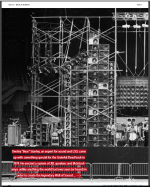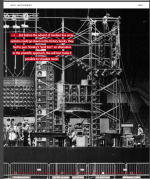Not sure what you mean, Jan. I've done a lot of passive crossover work based on simulations and when measured, they were very close. Of course I used an impedance sweep of the actual driver in the sim, so that helped.YIn that sense, sims of passive xovers are pretty useless except for a very, very rough proof of concept.
When I ran a frequency plot at the terminals of the driver connected to the crossover, the plot always matched the simulated filter function. There are other people here who have done the same using different simulators.
Or did you mean something else?
Hmm. What would that be? I've built and modified a number of DACs where I could change the filter. I did hear some differences, but pretty subtle. Nothing I would rate as clear and distinctive. Maybe your chip has a broader range of control?
No idea what yours does.
I'll know more when the new board is set up and I can freely download other filters and use RePhase to build my own too...
...the changes to dynamics and soundfield are significant, not subtle.
Regardless, my conclusion thus far is that with the digital playback in general (and the effects are lessened with the higher sample rate sources) the method as a whole is an attempt to create a series of compromises that end up being "reasonable" and "acceptable". In otherwords, no part of it is quite "correct".
No, you can't know what my DAC chips did if I didn't list it.  But I was asking what chipset YOU are using, perhaps it has filter options over a range that is greater than normal.
But I was asking what chipset YOU are using, perhaps it has filter options over a range that is greater than normal.
FYI, I've used SONY, Burr-Brown, Cirrus, AKM and ESS DAC chips. I can't be sure that I tested different filters on the ESS.
FYI, I've used SONY, Burr-Brown, Cirrus, AKM and ESS DAC chips. I can't be sure that I tested different filters on the ESS.
Not sure what you mean, Jan. I've done a lot of passive crossover work based on simulations and when measured, they were very close. Of course I used an impedance sweep of the actual driver in the sim, so that helped.
When I ran a frequency plot at the terminals of the driver connected to the crossover, the plot always matched the simulated filter function. There are other people here who have done the same using different simulators.
Or did you mean something else?
No I think we are on the same sheet. You replaced the 8 ohms speaker with the actual impedance plot - not ' that helped' but is crucial to realistic results!
Jan
Some people can listen to a symphony or other music and transcribe every note by ear. For most untrained people, they mostly hear the highest pitch note being played at one time, with the rest of the harmony is much less distinctly perceived.
I still suspect that with some distortion and other subtleties, hearing them must usually be learned. Once learned, such effects can be hard not to hear. And as with the skill of musical transcription, some people will be able to develop more skill than others.
Regarding amp distortion specs relative to full power output, I also suspect that some people listen the sound of an amp a various volume levels including sometimes very low volume where a little residual hiss can be heard. It may be that many amps do sound different to a trained or talented listener at very low volumes and close up to the speakers. At least, that might be a good point at which to start training to notice whatever is there.
I still suspect that with some distortion and other subtleties, hearing them must usually be learned. Once learned, such effects can be hard not to hear. And as with the skill of musical transcription, some people will be able to develop more skill than others.
Regarding amp distortion specs relative to full power output, I also suspect that some people listen the sound of an amp a various volume levels including sometimes very low volume where a little residual hiss can be heard. It may be that many amps do sound different to a trained or talented listener at very low volumes and close up to the speakers. At least, that might be a good point at which to start training to notice whatever is there.
No, you can't know what my DAC chips did if I didn't list it.But I was asking what chipset YOU are using, perhaps it has filter options over a range that is greater than normal.
FYI, I've used SONY, Burr-Brown, Cirrus, AKM and ESS DAC chips. I can't be sure that I tested different filters on the ESS.
Built from scratch stuff, or in commercial products?
And how have you imported filters, what chipset permits that, none I know of until fairly recently?
I'd have to look at what that box is using... has some Xmos thingie, and I dunno what else: SMSL M8 is the item. Inexpensive. Not as inexpensive as some things on ebay, etc...
http://www.diyaudio.com/forums/digital-source/269120-smsl-m8-dac.html
Figured I'd try it out and see what's going on in the DAC world today.
Regarding voltage out DACs and DIY DACs, both can be found here on DiyAudio: http://www.diyaudio.com/forums/vendors-bazaar/259488-reference-dac-module-discrete-r-2r-sign-magnitude-24-bit-384-khz.html Enjoy the reading... the newest version obviates much of the issues raised early in the thread... fwiw.
_-_-bear
Some people buy the marketing story that is very true.
One must yield to a superior knowledge and logic...
Some people can listen to a symphony or other music and transcribe every note by ear. For most untrained people, they mostly hear the highest pitch note being played at one time, with the rest of the harmony is much less distinctly perceived.
<snip>
This is not quite accurate, but close.
I think the term is called "leading tone"?
Jazz guitarists use the technique to play a melody line using chords...
_-_-
John Curl,
could you send me a copy of the schematic for the Parasound HCA1200 so I can look at it for Scott? I just want to look at some of the basic functions and see if I can determine what I hurt when it I oscillated it. May just be an output zobel or something simple.
Thanks in advance,
Steven
could you send me a copy of the schematic for the Parasound HCA1200 so I can look at it for Scott? I just want to look at some of the basic functions and see if I can determine what I hurt when it I oscillated it. May just be an output zobel or something simple.
Thanks in advance,
Steven
This is not quite accurate, but close.
I think the term is called "leading tone"?
Jazz guitarists use the technique to play a melody line using chords...
_-_-
I believe a leading tone is something more like a note that is dissonant with the current harmony, and that will be resolved by, or be consonant with, the next harmony (by the next chord change, in the simplest sense). In other words, it leads to, or makes an immediately upcoming harmonic change, sound natural and satisfying.
On the other hand, psychoacoustically speaking, untrained listeners tend to focus on the highest note currently being played, and they find it more difficult to identify the middle notes in a chord (or harmony, more generally). That's why vocal melodies are usually the highest pitch being played at one time in a song. Not always, but usually.
Last edited:
I understand your points, but I don't think a DIYer could design and develop a top quality state of the art DAC for only the cost of a bag of components. As a practical matter, one would need a well equipped lab with state of the art test equipment. By the time all is said and done, the DIY cost of design and development and testing something equivalent to a DAC-2 would probably be much more than just going out and buying one.
If I am wrong and some DIYer can design a DAC of that caliber for cheap, then by all means publish it here and everyone will have good cause to be very happy.
Plenty of kits out there for one matter, and then there's the whole AKM445x series which, looking at the datasheet a number of times, doesn't look *that* hard to communicate with. And the specs are nothing to sneeze at, especially at 2VRM output. The fact that they have a volume control built in is a tidy bonus and look pretty ideal for a one-stop shop for an DSP-driven system.
Oh and these chips are readily accessible from digikey for very modest prices.
As to the latter part about time to design/build vs buy: that's universal. So if that's not a fun part of the process then, yes, DIYAudio is probably no the wisest choice (and, no, not talking about the site, the pursuit).
Plenty of kits out there for one matter...
I would agree if when it comes to qualtiy we are talking primarily about average to good quality DACs. But, if we are talking about state of the art performance DACs, I am not aware of any kits or DIY designs that can compete with a DAC-2. However, I would be interested in finding such a thing. Is there some particular kit or DIY design you would recommend as equivalent?
ODAC?
https://www.jdslabs.com/products/39/odac-objectivedac/
https://benchmarkmedia.com/products/benchmark-dac2-hgc-digital-to-analog-audio-converter (you have to click on the specifications tab to compare)
They don't look all that equivalent to me. Has anyone done a listening comparison?
NwAvGuy: ODAC Released
Nwavguy owned a DAC-1 and compared ODAC to it and claims they are equally transparent. It doesn't have the Input capabilities of the benchmark, and is merely one person's aim at transparent, but I have a hard time seeing where it is lacking.
P.S. Not for me as I need I2S or SPDIF inputs
P.P.S. I would buy a DAC2 if I were as minted as RNM for at least one of my systems, but I'm not so I wont.
Nwavguy owned a DAC-1 and compared ODAC to it and claims they are equally transparent. It doesn't have the Input capabilities of the benchmark, and is merely one person's aim at transparent, but I have a hard time seeing where it is lacking.
P.S. Not for me as I need I2S or SPDIF inputs
P.P.S. I would buy a DAC2 if I were as minted as RNM for at least one of my systems, but I'm not so I wont.
There are a couple ES9018 (or whatever the newest flavor is) out there, too.
But, then again, it's hard not to believe that's moving towards meaningless specmanship when we're talking PPB of error/distortion products.
That could be. It's why I asked about listening tests. There are lots of DAC-1s and DAC-2s in mastering labs and high end studios, and I don't think it's because of specs, or simply due to good marketing. Probably the only way to convince oneself how good it is possible for a DAC to be is listen to one where you can carefully compare it to other competitive products.
- Status
- Not open for further replies.
- Home
- Member Areas
- The Lounge
- John Curl's Blowtorch preamplifier part II

